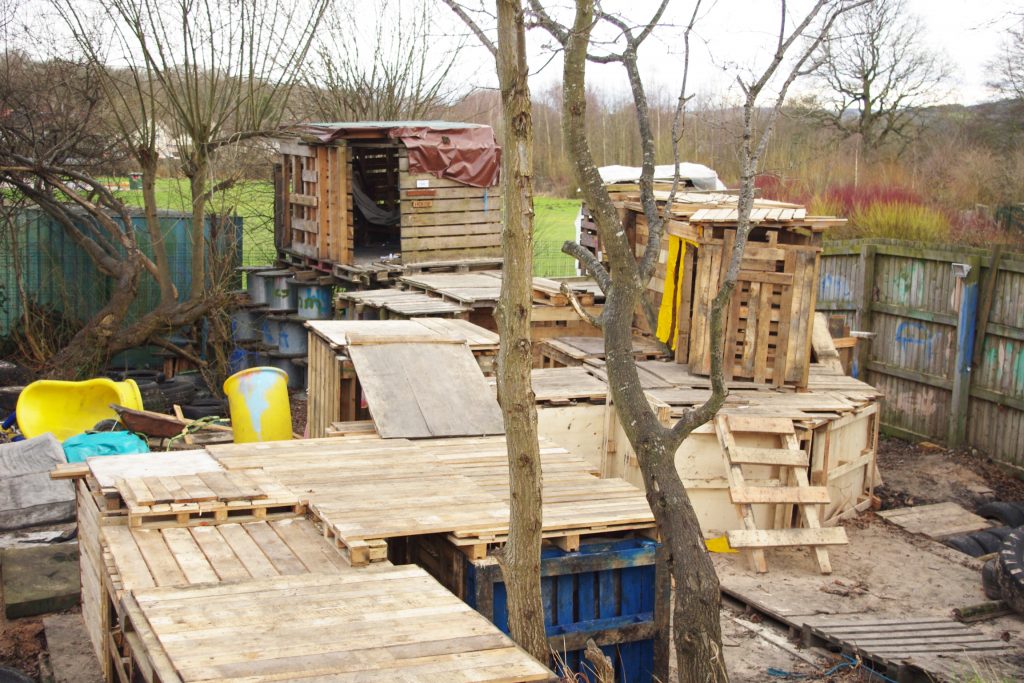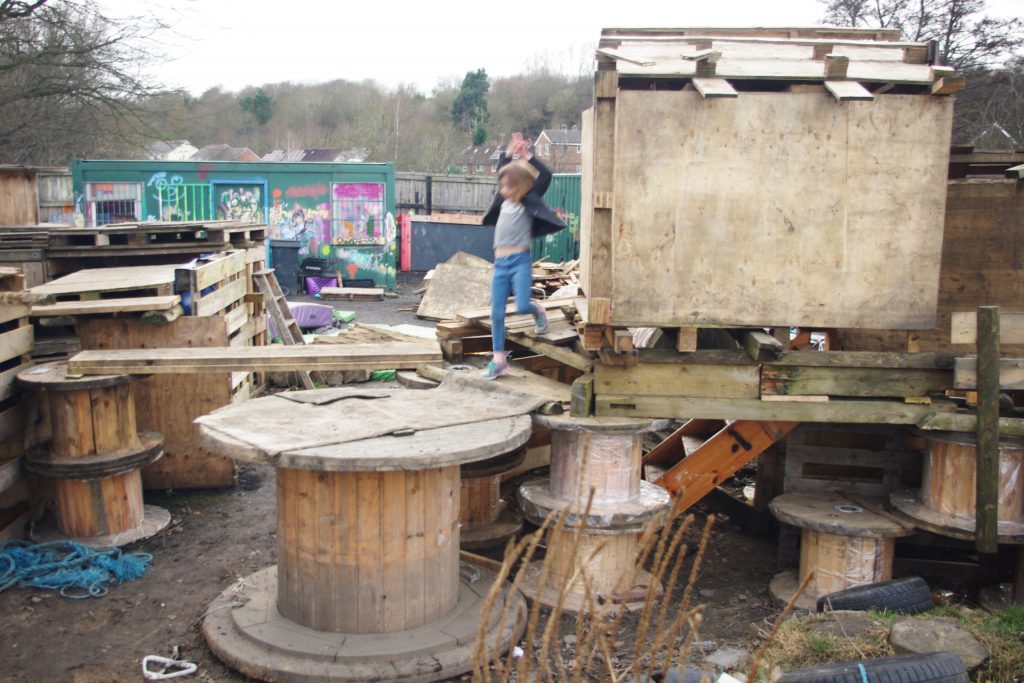Inspiring loose parts play

Kitcamp: a new inspiration for loose parts play
You may not have heard the term ‘loose parts’ before, but you’ll recognise the type of play. Imagine a child tinkering with a collection of seemingly unrelated objects, e.g. sticks, pine cones, cardboard tubes, shells and buttons. They’ll use these bits and bobs to build a tower, as props in role play, or to create a den. In 1971, Simon Nicholson coined the phrase ‘loose parts’ in his Theory of Loose Parts: How Not to Cheat Children.
“(Loose Parts are) materials that can be moved, carried, combined, redesigned, lined up, and taken apart and put back together in multiple ways. They are materials with no specific set of directions that can be used alone or combined with other materials.”
Encourage creativity and imagination
In his paper Nicholson, a landscape architect, describes children as being born creative and imaginative and argues that play environments need to be open and interactive for children to be active participants. He proposes that adults ‘de-restrict the world for young children’ by creating play spaces full of loose parts (or ‘variables’) such as shapes, materials, water and even smells for children to interact with, in endless ways. This proposal contrasts with prescribed, static and unchanging play environments, conceived and designed by adults, in which children have limited scope for using their creativity and imaginations. Compare a fixed, pre-prepared climbing apparatus with collections of crates full of multi-functional materials.
What does Loose Parts Play look like?

The Land swing. Credit Anna Saunt
The Land adventure playground in Plas Madoc, North Wales is the antithesis of playground design. Its entry sign reads “A Space Full of Possibilities” and invites children to play in a fenced-off grassy wasteland full of loose parts, large and small. To the uninitiated eye, it is a scrapheap, filled with ropes, netting, mattresses, hammers, nails and scraps of wood. The Land is an ever-changing space for children to create and build through their own eyes, where children move, carry, combine, recombine and design the junk parts as they choose. There are pallet walkways, tyre piles, reel towers, fires (the only rule is for a nearby adult and bucket of water!). It seems wild but free and engages through independence, infinite possibilities and the evolving space. The Land is full of potential hazards, but the philosophy is that children become empowered when they manage risks for themselves. Claire Griffiths, The Land’s creator, explains, “I loved giving children a space where they could just be children, where they could try and fail without being judged or assessed”. It might not look pretty, but it’s certainly a play space where children, and teenagers, want to be.
“I loved giving children a space where they could just be children, where they could try and fail without being judged or assessed”
Claire Griffiths, The Land’s creator.
- The Land, north Wales.
- A girl jumping across The Land
Loose parts in educational settings
The Land seems the ultimate expression of free play and loose parts theory, but can it be replicated in a school context with larger groups of children? Since 2007, Scrapstore Playpods have supported loose parts play in schools and early years settings throughout the U.K. They provide ‘pods’ teeming with scrap materials such as cardboard tubes, tyres, lengths of material, netting, ropes, crates and bins to encourage children’s play.
‘(The) non-prescriptive nature of these loose parts in combination with children’s inventiveness and creativity … (enables) all ages, genders and abilities to find ways to play and socialise together.’
Alongside the Playpods they recognise the need to train all stakeholders (children, teachers, parents and play supervisors) in the process and procedures for loose parts play to optimise its effects.
Inspiring Scotland and Playground Ideas have published guides for loose parts provision.
Involve children in the design
Nicholson argued that children should be involved in the design and invention of their playspaces; by measuring, drawing, designing, model making and constructing for themselves. He suggested that the trained adult designers and architects had put themselves in charge of the best part of the process! Instead, he proposed that children have access to ‘space forming’ materials to invent, construct and modify their own play space. Nicholson used the example of caves, suggesting children create their cave, rather than just manipulating their play within a given, prepared cave.
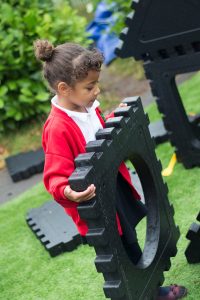
A lightweight Kitcamp panel.
Kitcamp panels are ‘space forming materials’; in a short time, children learn how to construct with the panels and to modify and adorn their own structures. While Kitcamp panels are not pure loose parts, with specific guidelines about fitting panel-to-panel and creating safe and stable structures (to meet stringent EU standards and Health and Safety requirements), they are versatile and child-friendly. The 60 cm square panels are lightweight (approx. 1kg per panel), yet robust enough for children as young as three to manipulate and create their own play spaces, independently of adults. Add other loose parts to the Kitcamp kit to transform the play space; the orange plugs, yellow bendy safety straps, fabric sails and cardboard inserts are loose parts in their own right. The orange plugs, designed to secure the inserts and straps, become hooks, and holders for ropes, sticks and pulleys. Children use them for far more purposes than we, the Kitcamp ‘professionals’, could ever have imagined; a vivid demonstration of loose parts!
How do I organise the ugly and messy ‘loose parts’?
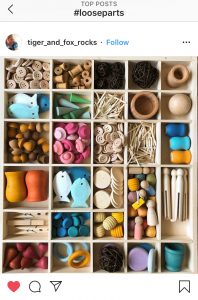
Instagram #looseparts. © Jacqui Lewis of Tiger and Fox Rocks
The question of storing loose parts is often raised. Complaints that they look messy or create an ugly environment (to our adult minds) are rife. While this is often unimportant to children, there is a need to organise the myriad of loose parts to make them optimally accessible to all. To facilitate ‘loose parts play’, there needs to be a system for getting out, tidying, finding and putting away loose parts; it’s about creating a collective responsibility and respect for the bits and bobs. Scrapstore Playpods provide their scrap materials in a shipping container or a shed with shelving. A quick Instagram search of #looseparts offers visual solutions, such as screw lid jars and labelled see-through boxes. Kitcamp offers a storage solution; keep containers of loose parts inside Kitcamp cubes before and after play. Kitcamp all-weather zipped holdalls are designed to pack away 7 Kitcamp panels, and their carry straps can be hung on hooks or tucked into a corner.
Empower Creativity
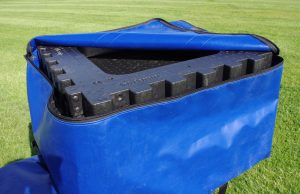
Kitcamp weatherproof storage bags.
Kitcamp’s versatile modular play resource is designed to harness and inspire children’s incredible learning potential through play. See Kitcamp in action, arrange a demonstration and discuss how Kitcamp will enhance play opportunities in your context. Contact us.
Further reading:
A modern review of Loose Parts Theory.
Adventure and junk playgrounds.

